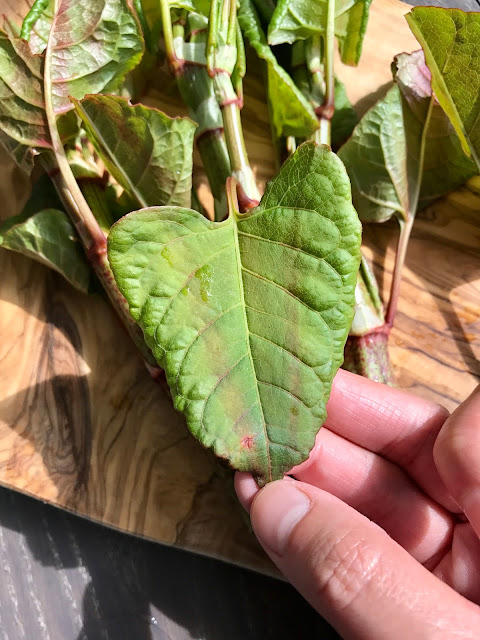Have you seen Japanese knotweed before? It is a beautiful plant that may remind you of bamboo. I think it was the reason why knotweed was introduced to North America from Japan as an ornamental plant long time ago.
In Japan and China, people are more focused on the medical benefits of the knotweed. Knotweed contains a high amount of resveratrol, a potent antioxidant compound that can also be found in red grape skin or blueberry. I'm not an expert on this one so I can't tell you much about how this organic compound works in our body.
For me, knotweed is a gift from nature and it tastes wonderful. It has the tangy and subtle sweet flavour that resembles rhubarb.
 |
| Knotweed on the left, and horsetail grass on the right |
Before I came across Japanese knotweed, I more often encountered horsetail grass, a species that looks very much like knotweed. However, you can distinguish them very easily.
In spring, Japanese knotweed is plump and round, and has reddish purple dots. The leaves are heart shaped with two subtle purple lines on each. Horsetail has no spots on the stem, and it has papery texture. Both species are bamboo-like and invasive; however, knotweed is edible and the other is not.
 |
| A young leaf of the Japanese knotweed. The two lines will subside when the leaf grows more mature. |
 |
| Knotweed |
Young knotweed usually starts to come out in early April. This fast growing species can grow nearly 10 cm each day up to 3 meters in height, and the root can spread up to 10 feet in depth. The root system is very vigorous and can even break through concrete, causing much damage in houses or roads. A strong reason why our Government wants to get rid of it and puts it under the Invasive Special Act. I think our government has done a very good job because I rarely see knotweed around to forage anymore.
When foraging knotweed, we look for the young shoots that are easy to break off and are no more than 6 inches tall. Past this stage, the plants will start to become woody and will no longer be good for consumption.
Since Japanese knotweed tastes tangy and sweet, I used it to make some knotweed jam for the yogurt dessert.
Japanese Knotweed Jam
Ingredients:
1/2 cup Young Knotweed Shoots
3 tablespoons Sugar
3 tablespoons Rum Raisin
 |
I infused the raisin three years ago and I only use it for special dessert. If you don't have some on hand, just use raisin and a splash of rum. Or just omit the rum.
|
How to make:
1. Rinse the knotweed carefully; cut it into bite sized pieces.
2. In a non-stick pot, add the knotweed and a cup of water. Bring it to a boil and cook continuously until the knotweed is totally soft and the liquid has almost evaporated. It takes about 5 minutes.
3. Pour the cooked knotweed in a blender, including the cooking liquid. Add raisin. Pulse until the mixture incorporates.
 |
| Japanese knotweed Jam |
Da, da, da, da~
It is the dessert for tonight. I must say it feels great to eat the food I forage or grow with my own hands. There is a bond between the nature and the me inside.
 |
Knotweed jam on greek yogurt, plus some hemp seeds and bean cracker for the garnish.
|






No comments:
Post a Comment